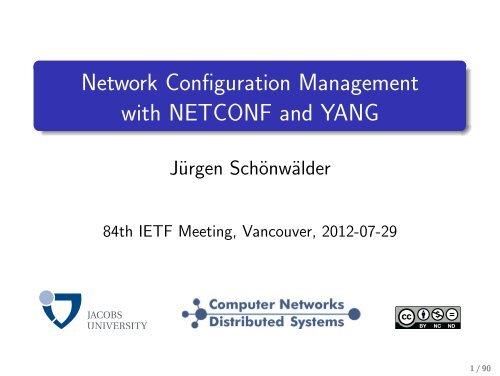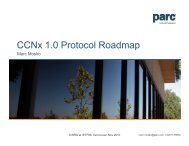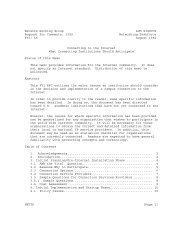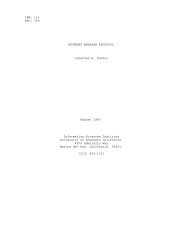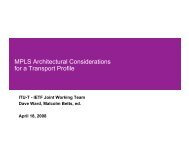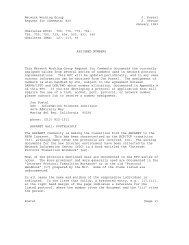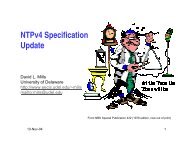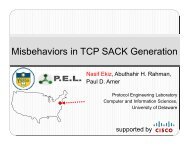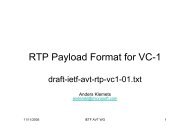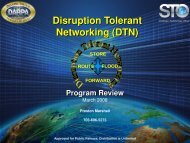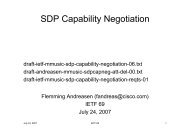Network Configuration Management with NETCONF and YANG - IETF
Network Configuration Management with NETCONF and YANG - IETF
Network Configuration Management with NETCONF and YANG - IETF
You also want an ePaper? Increase the reach of your titles
YUMPU automatically turns print PDFs into web optimized ePapers that Google loves.
<strong>Network</strong> <strong>Configuration</strong> <strong>Management</strong><br />
<strong>with</strong> <strong>NETCONF</strong> <strong>and</strong> <strong>YANG</strong><br />
Jürgen Schönwälder<br />
84th <strong>IETF</strong> Meeting, Vancouver, 2012-07-29<br />
1 / 90
<strong>Network</strong> <strong>Management</strong> Protocol Soup<br />
GDMO/CMIP<br />
[OSI]<br />
SMI/SNMP<br />
[<strong>IETF</strong>]<br />
IE/IPFIX<br />
[<strong>IETF</strong>]<br />
TL1<br />
[TELCORDIA]<br />
CLI<br />
[VENDORS]<br />
DME/DCE<br />
[OSF]<br />
CMIN/WBEM<br />
[DMTF]<br />
TR069/SOAP<br />
[BROADBANDFORUM]<br />
DEN/LDAP<br />
[DMTF]<br />
TINA/ODL/CORBA<br />
[TINA−C]<br />
SYSLOG<br />
[BSD/<strong>IETF</strong>]<br />
SID/TAM<br />
[TMFORUM]<br />
EC2<br />
[AMAZON]<br />
<strong>YANG</strong>/<strong>NETCONF</strong><br />
[<strong>IETF</strong>]<br />
SPPI/COPS−PR<br />
[<strong>IETF</strong>]<br />
POLICY/COPS<br />
[<strong>IETF</strong>]<br />
⊲ See RFC 6632 for further details about the <strong>IETF</strong>’s<br />
contribution to the network management protocol soup.<br />
2 / 90
Today’s Menu . . .<br />
<strong>NETCONF</strong><br />
The <strong>Network</strong> <strong>Configuration</strong> Protocol (<strong>NETCONF</strong>) provides<br />
mechanisms to install, manipulate, <strong>and</strong> delete the<br />
configuration of network devices. [RFC 6241]<br />
<strong>YANG</strong><br />
<strong>YANG</strong> is a data modeling language used to model<br />
configuration <strong>and</strong> state data manipulated by the <strong>Network</strong><br />
<strong>Configuration</strong> Protocol (<strong>NETCONF</strong>), <strong>NETCONF</strong> remote<br />
procedure calls, <strong>and</strong> <strong>NETCONF</strong> notifications. [RFC 6020]<br />
3 / 90
<strong>Configuration</strong> <strong>Management</strong><br />
[15 min]<br />
1 <strong>Configuration</strong> <strong>Management</strong> [15 min]<br />
2 <strong>NETCONF</strong> Protocol [20 min]<br />
3 <strong>YANG</strong> Data Modeling Language [20 min]<br />
4 Core <strong>Configuration</strong> Data Models [15 min]<br />
5 Implementations, Tools, <strong>and</strong> Usage [10 min]<br />
6 Future Directions [10 min]<br />
7 Discussion [20 min]<br />
4 / 90
“The <strong>Network</strong> is the Record”<br />
Policy <strong>Management</strong><br />
Systems<br />
Service <strong>Management</strong><br />
Systems<br />
<strong>Network</strong> Topology<br />
Information<br />
<strong>Network</strong> Status <strong>and</strong><br />
Performance Information<br />
Device<br />
<strong>Configuration</strong><br />
Device<br />
<strong>Configuration</strong><br />
Device<br />
<strong>Configuration</strong><br />
Device<br />
<strong>Configuration</strong><br />
Device<br />
<strong>Configuration</strong><br />
<strong>Configuration</strong><br />
Backup<br />
Repository<br />
⊲ <strong>Network</strong> operators typing / scripting proprietary CLIs<br />
⊲ Often coupled <strong>with</strong> a backup repository to track changes<br />
⊲ Labor intensive, expensive, error prone, widely deployed<br />
5 / 90
“Generate Everything” (RFC 3139)<br />
Policy <strong>Management</strong><br />
Systems<br />
Service <strong>Management</strong><br />
Systems<br />
<strong>Network</strong> Topology<br />
Information<br />
<strong>Network</strong>−Wide<br />
<strong>Configuration</strong><br />
Database<br />
<strong>Network</strong> Status <strong>and</strong><br />
Performance Information<br />
<strong>Configuration</strong> Data<br />
Translator<br />
Device<br />
<strong>Configuration</strong><br />
Device<br />
<strong>Configuration</strong><br />
Device<br />
<strong>Configuration</strong><br />
Device<br />
<strong>Configuration</strong><br />
Device<br />
<strong>Configuration</strong><br />
⊲ Changes go to a network-wide configuration database<br />
⊲ Device configurations are automatically pushed to devices<br />
⊲ Devices are (ideally) never touched manually<br />
6 / 90
<strong>Configuration</strong> <strong>Management</strong> Requirements<br />
R1 A configuration management protocol must be able to<br />
distinguish between configuration state <strong>and</strong> operational<br />
state. (configuration state vs. operational state)<br />
⊲ <strong>Configuration</strong> state:<br />
• Everything explicitely configured (e.g., IP addresses<br />
assigned manually to network interfaces)<br />
⊲ Operational state:<br />
• Usage <strong>and</strong> error counters obtained by the device<br />
• State learned from interaction <strong>with</strong> other devices<br />
(e.g., an IP address obtained from a DHCP server)<br />
7 / 90
<strong>Configuration</strong> <strong>Management</strong> Requirements<br />
R2 A configuration management protocol must provide<br />
primitives to prevent errors due to concurrent<br />
configuration changes. (concurrency support)<br />
⊲ Goal: Prevent two operators from making configuration<br />
changes simultaneously that lead to undesired results<br />
⊲ Requires either strict locking or a conflict resolution<br />
mechanism<br />
⊲ Computer programs generally deal better <strong>with</strong> strict<br />
locking, conflict resolution requires intelligence<br />
⊲ Scope of locks determines how much concurrency is<br />
possible<br />
8 / 90
<strong>Configuration</strong> <strong>Management</strong> Requirements<br />
R3 A configuration management protocol must provide<br />
primitives to apply configuration changes to a set of<br />
network elements in a robust <strong>and</strong> transaction-oriented<br />
way. (configuration transactions)<br />
⊲ Example: renumbering a whole network<br />
• All devices need to pick up new addresses<br />
• During the renumbering process (activation of a new<br />
configuration), connectivity might be temporarily lost<br />
• Devices need to be able to decide whether they keep the<br />
new configuration (addressing scheme) or rollback to the<br />
previous configuration<br />
9 / 90
<strong>Configuration</strong> <strong>Management</strong> Requirements<br />
R4 A configuration management protocol must be able to<br />
distinguish between several configurations <strong>and</strong> devices<br />
should be able to hold multiple configurations. (multiple<br />
configurations)<br />
⊲ <strong>Configuration</strong>s can become large <strong>and</strong> complex<br />
⊲ Often useful to keep a few configurations on the device to<br />
easily switch between them (backup configs)<br />
⊲ Distinction between the running configuration <strong>and</strong> the<br />
configuration used at next re-initialization<br />
10 / 90
<strong>Configuration</strong> <strong>Management</strong> Requirements<br />
R5 It is important to distinguish between the distribution of<br />
configurations <strong>and</strong> the activation of a certain<br />
configuration. (distribution vs. activation)<br />
⊲ Example: peak hours vs. off-peak hours<br />
• An operator wants to turn off links during off-peak hours<br />
• This might happen once per day or even more frequently<br />
• Instead of shipping a complete new configuration each<br />
time, it is much more efficient to activate a different<br />
already locally stored configuration<br />
⊲ Implementations may internally keep data derived from<br />
known locally stored configurations in order to make the<br />
activation as smooth as possible<br />
11 / 90
<strong>Configuration</strong> <strong>Management</strong> Requirements<br />
R6 A configuration management protocol must be clear<br />
about the persistence of configuration changes.<br />
(persistence of configuration state)<br />
⊲ Sometimes changes are temporary <strong>and</strong> should be<br />
forgotten after the next restart of a device<br />
⊲ Sometimes changes should be applied immediately <strong>and</strong> be<br />
remembered after reboots<br />
⊲ Sometimes changes should only be applied at the next<br />
restart of a device<br />
12 / 90
<strong>Configuration</strong> <strong>Management</strong> Requirements<br />
R7 A configuration management protocol must be able to<br />
report configuration change events. (configuration change<br />
events)<br />
⊲ Example: firewall rules break applications<br />
• Customers report that certain applications suddenly fail<br />
to function correctly<br />
• Reason: A new firewall rule causes certain messages<br />
these applications rely on to be blocked<br />
⊲ A log of configuration change events often helps during<br />
fault isolation / resolution<br />
13 / 90
<strong>Configuration</strong> <strong>Management</strong> Requirements<br />
R8 A full configuration dump <strong>and</strong> a full configuration restore<br />
are primitive operations frequently used by operators <strong>and</strong><br />
must be supported appropriately. (configuration dump<br />
<strong>and</strong> restore)<br />
⊲ This seems to be rather obvious to operators<br />
⊲ Some network management protocols fail badly here<br />
14 / 90
<strong>Configuration</strong> <strong>Management</strong> Requirements<br />
R9 A configuration management protocol must represent<br />
configuration state <strong>and</strong> operational state in a form<br />
enabling the use of existing tools for comparison,<br />
conversion, <strong>and</strong> versioning. (support for st<strong>and</strong>ard tools)<br />
⊲ Many operators use home-grown software systems<br />
⊲ Such systems often rely on st<strong>and</strong>ard tools for processing<br />
network management data<br />
⊲ Data formats enabling the use of off the shelf tools<br />
• eases integration<br />
• saves time<br />
• cuts costs<br />
15 / 90
<strong>Configuration</strong> <strong>Management</strong> in the <strong>IETF</strong><br />
No Description SNMP <strong>NETCONF</strong><br />
R1 config vs. oper state - +<br />
R2 concurrency support o +<br />
R3 config transactions - [+]<br />
R4 multiple configs - [+]<br />
R5 distribution vs. activation - [+]<br />
R6 persistence of config state o +<br />
R7 config change notifications - +<br />
R8 config dump <strong>and</strong> restore - +<br />
R9 support of st<strong>and</strong>ard tools - +<br />
⊲ These requirements originate from an IAB workshop that<br />
paved the way for <strong>NETCONF</strong> <strong>and</strong> <strong>YANG</strong> [RFC3535]<br />
16 / 90
<strong>NETCONF</strong> <strong>and</strong> <strong>YANG</strong> Timeline<br />
Date Milestone<br />
Jun 2002 IAB network management workshop<br />
May 2003 <strong>NETCONF</strong> working group established<br />
— work work work —<br />
Dec 2006 <strong>NETCONF</strong> 1.0 RFCs published<br />
Apr 2008 NETMOD working group established<br />
— work work work —<br />
Oct 2010 <strong>YANG</strong> 1.0 RFCs published<br />
Jun 2011 <strong>NETCONF</strong> 1.1 RFCs published<br />
— tutorial <strong>IETF</strong> 84 —<br />
Q4 2012 Core configuration data models published<br />
17 / 90
<strong>NETCONF</strong> Protocol<br />
[20 min]<br />
1 <strong>Configuration</strong> <strong>Management</strong> [15 min]<br />
2 <strong>NETCONF</strong> Protocol [20 min]<br />
3 <strong>YANG</strong> Data Modeling Language [20 min]<br />
4 Core <strong>Configuration</strong> Data Models [15 min]<br />
5 Implementations, Tools, <strong>and</strong> Usage [10 min]<br />
6 Future Directions [10 min]<br />
7 Discussion [20 min]<br />
18 / 90
<strong>NETCONF</strong> RFCs (as of today)<br />
RFC Status Content<br />
RFC 6241 PS <strong>NETCONF</strong> Protocol Version 1.1<br />
RFC 6242 PS <strong>NETCONF</strong> over SSH Version 1.1<br />
RFC 6243 PS <strong>NETCONF</strong> With-defaults Capability<br />
RFC 6470 PS <strong>NETCONF</strong> Base Notifications<br />
RFC 6536 PS <strong>NETCONF</strong> Access Control Model<br />
RFC 5717 PS <strong>NETCONF</strong> Partial Locking<br />
RFC 5277 PS <strong>NETCONF</strong> Event Notifications<br />
RFC 6022 PS <strong>NETCONF</strong> Monitoring<br />
RFC 6244 I <strong>NETCONF</strong> / <strong>YANG</strong> Architecture<br />
⊲ Further RFCs define additional transports<br />
⊲ Some of the transports may be declared historic soon<br />
19 / 90
Deployment Model<br />
<strong>NETCONF</strong><br />
Manager<br />
Server<br />
Applications<br />
Remote<br />
<strong>NETCONF</strong> CLI<br />
CLI<br />
Client<br />
Client<br />
CLI<br />
Client<br />
Server<br />
Server<br />
Agent<br />
Server<br />
Instrumentation<br />
<strong>NETCONF</strong> Device<br />
Instrumentation<br />
<strong>NETCONF</strong> Device<br />
Instrumentation<br />
<strong>NETCONF</strong> Device<br />
⊲ <strong>NETCONF</strong> enabled devices include a <strong>NETCONF</strong> server<br />
⊲ <strong>Management</strong> applications include a <strong>NETCONF</strong> client<br />
⊲ Device CLIs can be a wrapped around a <strong>NETCONF</strong> client<br />
20 / 90
Layering Model (RFC6241)<br />
Layer<br />
Example<br />
Content<br />
<strong>Configuration</strong> Data<br />
Notification Data<br />
Operations<br />
, <br />
Messages<br />
, <br />
<br />
Secure Transport<br />
SSH, TLS, (BEEP/TLS), (SOAP/HTTP/TLS), ...<br />
⊲ Security is provided by the transport layer<br />
⊲ Operations focus on primitives to manage configurations<br />
⊲ The set of operations is designed to be extensible<br />
21 / 90
<strong>Configuration</strong> Datastores (RFC6241)<br />
A configuration datastore is the complete set of configuration<br />
information that is required to get a device from its initial<br />
default state into a desired operational state.<br />
⊲ The configuration datastore represents the<br />
currently active configuration of a device <strong>and</strong> is always<br />
present<br />
⊲ The configuration datastore represents the<br />
configuration that will be used during the next startup<br />
⊲ The configuration datastore represents a<br />
configuration that may become a <br />
configuration through an explicit commit<br />
22 / 90
Transaction Models (RFC6241)<br />
Direct Model<br />
<br />
running<br />
C<strong>and</strong>idate Model (optional)<br />
<br />
c<strong>and</strong>idate<br />
<br />
running<br />
Distinct Startup Model (optional)<br />
<br />
<br />
running<br />
<br />
startup<br />
⊲ Some operations (edit-config) may support different<br />
selectable error behaviours, including rollback behaviour<br />
23 / 90
Capability Exchange (RFC6241)<br />
After estabilishing a session over a secure transport, both<br />
<strong>NETCONF</strong> protocol engines send a hello message to<br />
announce their protocol capabilities, the supported data<br />
models, <strong>and</strong> the server’s session identifier.<br />
S: <br />
S: <br />
S: <br />
S: urn:ietf:params:xml:ns:netconf:base:1.1<br />
S: <br />
S: <br />
S: urn:ietf:params:xml:ns:netconf:capability:startup:1.0<br />
S: <br />
S: <br />
S: urn:ietf:params:xml:ns:yang:ietf-interfaces?<br />
S: module=ietf-interfaces&revision=2012-04-29<br />
S: <br />
S: <br />
S: 4<br />
S: <br />
24 / 90
Remote Procedure Calls (RFC6241)<br />
The Remote Procedure Call (RPC) protocol consists of a<br />
message followed by an message.<br />
C: <br />
C: <br />
C: <br />
C: <br />
C: <br />
C: <br />
C: <br />
S:
Remote Procedure Calls (RFC6241)<br />
RPC failures are indicated by one or more <br />
elements contained in the element.<br />
C: <br />
C: <br />
C: <br />
S: <br />
S: <br />
S: rpc<br />
S: missing-attribute<br />
S: error<br />
S: <br />
S: message-id<br />
S: rpc<br />
S: <br />
S: <br />
S: <br />
26 / 90
<strong>NETCONF</strong> Operations (RFC6241)<br />
⊲ get-config(source, filter) → data<br />
Retrieve all or part of the configuration datastore source.<br />
⊲ edit-config(target, default-operation,<br />
test-option, error-option, config)<br />
Edit the configuration datastore target by merging,<br />
replacing, creating, or deleting new config elements.<br />
The test-option parameter allows to do a “dry run”<br />
while the error-option parameter controls how the<br />
server reacts to errors (stop, continue, rollback).<br />
⊲ copy-config(target, source)<br />
Copy the content of the configuration datastore source<br />
to the configuration datastore target.<br />
27 / 90
<strong>NETCONF</strong> Operations (RFC6241)<br />
⊲ delete-config(target)<br />
Delete the named configuration datastore target.<br />
⊲ lock(target)<br />
Lock the configuration datastore target.<br />
⊲ unlock(target)<br />
Unlock the configuration datastore target.<br />
⊲ validate(source)<br />
Validate the configuration datastore source (:validate<br />
capability).<br />
28 / 90
<strong>NETCONF</strong> Operations (RFC6241)<br />
⊲ get(filter) → data<br />
Retrieve all or part of the running configuration data store<br />
<strong>and</strong> merged <strong>with</strong> the device’s state information.<br />
⊲ close-session()<br />
Gracefully close the current session.<br />
⊲ kill-session(session-id)<br />
Force the termination of the session session-id.<br />
29 / 90
<strong>NETCONF</strong> Operations (RFC6241)<br />
⊲ discard-changes()<br />
Revert the c<strong>and</strong>idate configuration datastore to the<br />
running configuration (:c<strong>and</strong>idate capability).<br />
⊲ commit(confirmed, confirm-timeout,<br />
persist, persist-id)<br />
Commit the c<strong>and</strong>idate to the running configuration<br />
datastore <strong>with</strong> an optional automatic rollback<br />
(:c<strong>and</strong>idate, :confirmed-commit capability).<br />
⊲ cancel-commit(persist-id)<br />
Cancel an ongoing confirmed commit identified by<br />
persist-id (:confirmed-commit capability).<br />
30 / 90
More <strong>NETCONF</strong> Operations (RFC5717, RFC5277)<br />
⊲ partial-lock(select)<br />
Create a partial lock on the running configuration<br />
datastore on the nodes / subtree identified by the select<br />
XPath expression (RFC 5717).<br />
⊲ partial-unlock(lock-id)<br />
Remove a previously established partial lock (RFC 5717).<br />
⊲ create-subscription(stream, filter,<br />
start, stop)<br />
Subscribe to a notification stream using an optional<br />
filter; the optional start/stop times support the<br />
replay of notifications (RFC 5277).<br />
31 / 90
Editing (Patching) <strong>Configuration</strong><br />
Embedded operation attributes specify how a configuration is<br />
modified by an edit-config() configuration.<br />
⊲ merge:<br />
<strong>Configuration</strong> data is merged <strong>with</strong> the configuration.<br />
⊲ replace:<br />
<strong>Configuration</strong> data replaces existing configuration.<br />
⊲ create:<br />
<strong>Configuration</strong> data is added iff it does not already exist.<br />
⊲ delete:<br />
<strong>Configuration</strong> data is deleted from the datastore.<br />
32 / 90
Editing (Patching) <strong>Configuration</strong> Example<br />
C: <br />
C: <br />
C: <br />
C: <br />
C: <br />
C: <br />
C: <br />
C: <br />
C: Ethernet0/0<br />
C: 1500<br />
C: <br />
C: <br />
C: <br />
C: <br />
C: <br />
33 / 90
Subtree Filtering<br />
Subtree filter expressions select XML subtrees to include in<br />
get <strong>and</strong> get-config responses (XPath expressions can be<br />
used as well if the :xpath capability is supported).<br />
⊲ namespace selection (wildcarding)<br />
A non-null namespace of a node in a subtree filter<br />
matches the node in the given namespace. A null<br />
namespace acts as a wildcard.<br />
⊲ attribute match expressions<br />
The set of XML attributes present in any type of filter<br />
node form an “attribute match expression”; the selected<br />
data must have matching values for every attribute of an<br />
attribute match expression.<br />
34 / 90
Subtree Filtering (cont.)<br />
⊲ containment nodes<br />
For each containment node of subtree filter, all data<br />
model instances must exactly match the specified<br />
namespaces, element hierarchy, <strong>and</strong> any attribute match<br />
expressions.<br />
⊲ selection nodes<br />
An empty leaf node of a filter selects the specified<br />
subtree(s) <strong>and</strong> it suppresses the automatic selection of<br />
the entire set of sibling nodes.<br />
⊲ content match nodes<br />
A leaf node of a filter containing simple content selects<br />
some or all of its sibling nodes.<br />
35 / 90
Subtree Filtering Example<br />
<br />
<br />
<br />
<br />
<br />
<br />
<br />
<br />
<br />
<br />
<br />
<br />
<br />
<br />
<br />
ethernet<br />
36 / 90
<strong>NETCONF</strong> over SSH (RFC6242)<br />
Motivation: Use an already widely deployed security protocol<br />
for CLIs, reducing the costs associated <strong>with</strong> key management.<br />
⊲ SSH supports multiple logical channels over one transport<br />
layer association<br />
⊲ For framing purposes, the special end of message marker<br />
]]>]]> is used for the initiall hello message<br />
⊲ Subsequent <strong>NETCONF</strong> 1.1 messages use a chunked<br />
framing format (if both parties use <strong>NETCONF</strong> 1.1)<br />
⊲ SSH is the m<strong>and</strong>atory to implement <strong>NETCONF</strong> transport<br />
37 / 90
<strong>NETCONF</strong> over SSH: End-of-Message Framing<br />
S: <br />
S: <br />
S: <br />
S: <br />
S: urn:ietf:params:xml:ns:netconf:base:1.1<br />
S: <br />
S: <br />
S: urn:ietf:params:xml:ns:netconf:capability:startup:1.0<br />
S: <br />
S: <br />
S: urn:ietf:params:xml:ns:yang:ietf-interfaces?<br />
S: module=ietf-interfaces&revision=2012-04-29<br />
S: <br />
S: <br />
S: 4<br />
S: <br />
S: ]]>]]><br />
⊲ Server announces protocol version, startup capability, <strong>and</strong><br />
the ietf-interfaces data model<br />
38 / 90
<strong>NETCONF</strong> over SSH: End-of-Message Framing<br />
C: <br />
C: <br />
C: <br />
C: <br />
C: urn:ietf:params:xml:ns:netconf:base:1.1<br />
C: <br />
C: <br />
C: <br />
C: ]]>]]><br />
⊲ Client announces protocol version<br />
⊲ Client <strong>and</strong> server switch to chunked framing<br />
(both announced support for <strong>NETCONF</strong> 1.1)<br />
39 / 90
<strong>NETCONF</strong> over SSH: Chunked Framing<br />
C: #350<br />
C: <br />
C: <br />
C: <br />
C: <br />
C: <br />
C: <br />
C: <br />
C: <br />
C: ethernetCsmacd<br />
C: <br />
C: <br />
C: <br />
C: <br />
C: ##<br />
⊲ Messages are send in chunks (limiting buffer sizes)<br />
⊲ Each chunk is prefixed by its length<br />
⊲ A special marker indicates the end of a message<br />
40 / 90
<strong>NETCONF</strong> over SSH: Chunked Framing<br />
S: #165<br />
S: <br />
S: <br />
S: <br />
S: #174<br />
S: <br />
S: eth0ethernetCsmacd<br />
S: 0true<br />
S: 2<br />
S: <br />
S: #174<br />
S: <br />
S: eth1ethernetCsmacd<br />
S: 1false<br />
S: 7<br />
S: <br />
S: #40<br />
S: <br />
S: <br />
S: <br />
S: ##<br />
41 / 90
<strong>YANG</strong> Data Modeling Language<br />
[20 min]<br />
1 <strong>Configuration</strong> <strong>Management</strong> [15 min]<br />
2 <strong>NETCONF</strong> Protocol [20 min]<br />
3 <strong>YANG</strong> Data Modeling Language [20 min]<br />
4 Core <strong>Configuration</strong> Data Models [15 min]<br />
5 Implementations, Tools, <strong>and</strong> Usage [10 min]<br />
6 Future Directions [10 min]<br />
7 Discussion [20 min]<br />
42 / 90
<strong>YANG</strong> RFCs (as of today)<br />
RFC Status Content<br />
RFC 6020 PS <strong>YANG</strong> Version 1<br />
RFC 6021 PS Common Data Types<br />
RFC 6087 PS Guidelines for Authors/Reviewers<br />
RFC 6095 E <strong>YANG</strong> Language Abstractions<br />
RFC 6110 PS Mapping <strong>YANG</strong> to DSDL<br />
RFC 6643 PS Mapping SMIv2 to <strong>YANG</strong><br />
RFC 6244 I <strong>NETCONF</strong> / <strong>YANG</strong> Architecture<br />
⊲ <strong>YANG</strong> data models can be found in RFC 6022, RFC<br />
6241, RFC 6243, RFC 6470, RFC 6536, . . .<br />
⊲ We expect this list to grow soon <strong>with</strong> your help<br />
43 / 90
<strong>YANG</strong>, YIN, XSD, RELAX NG, Schematron<br />
<strong>YANG</strong> is a data modeling language used to model<br />
configuration <strong>and</strong> state data manipulated by the <strong>NETCONF</strong><br />
protocol, <strong>NETCONF</strong> operations, <strong>and</strong> <strong>NETCONF</strong> notifications.<br />
⊲ <strong>YANG</strong> uses a compact syntax since human readability is<br />
highest priority<br />
⊲ YIN is an XML representation of <strong>YANG</strong> (lossless<br />
roundtrip conversion)<br />
⊲ <strong>YANG</strong> can be translated to XML Schema <strong>and</strong> RELAX NG<br />
so that existing XML tools can be utilized<br />
⊲ <strong>YANG</strong> can be translated to Schematron to validate<br />
<strong>NETCONF</strong> content<br />
44 / 90
Modules <strong>and</strong> submodules<br />
import<br />
include<br />
Module 1<br />
SubMod A<br />
Module 2<br />
SubMod X SubMod Y SubMod Z<br />
⊲ A module is a self-contained collection of <strong>YANG</strong><br />
definitions<br />
⊲ A submodule is a partial module definition which<br />
contributes derived types, groupings, data nodes, RPCs,<br />
<strong>and</strong> notifications to a module<br />
45 / 90
Module Example<br />
module ietf-inet-types {<br />
namespace "urn:ietf:params:xml:ns:yang:ietf-inet-types";<br />
prefix "inet";<br />
organization<br />
"<strong>IETF</strong> NETMOD (<strong>NETCONF</strong> Data Modeling Language) Working Group";<br />
contact<br />
"WG Web:<br />
";<br />
description<br />
"This module contains a collection of generally useful derived<br />
<strong>YANG</strong> data types for Internet addresses <strong>and</strong> related things.";<br />
revision 2010-09-24 {<br />
description<br />
"Initial revision.";<br />
reference<br />
"RFC 6021: Common <strong>YANG</strong> Data Types";<br />
}<br />
}<br />
46 / 90
Built-in Data Types<br />
Category Types Restrictions<br />
Integral {u,}int{8,16,32,64} range<br />
Decimals decimal64 range, fraction-digits<br />
String string length, pattern<br />
Enumeration enumeration enum<br />
Bool <strong>and</strong> Bits boolean, bits<br />
Binary binary length<br />
References leafref path<br />
References identityref base<br />
References instance-identifier<br />
Other<br />
empty<br />
⊲ The data type system is mostly an extension of the SMIng<br />
type system, accommodating XML <strong>and</strong> XSD requirements<br />
⊲ Compatible <strong>with</strong> the XSD / RelaxNG type systems<br />
47 / 90
Derived Types: typedef<br />
module ietf-inet-types {<br />
namespace "urn:ietf:params:xml:ns:yang:ietf-inet-types";<br />
prefix "inet";<br />
typedef ipv4-address {<br />
type string {<br />
pattern ’(([0-1]?[0-9]?[0-9]|2[0-4][0-9]|25[0-5])\.){3}’<br />
+ ’([0-1]?[0-9]?[0-9]|2[0-4][0-9]|25[0-5])’<br />
+ ’(%[\p{N}\p{L}]+)?’;<br />
}<br />
}<br />
typedef ip-address {<br />
type union {<br />
type inet:ipv4-address;<br />
type inet:ipv6-address;<br />
}<br />
description<br />
"The ip-address type represents an IP address <strong>and</strong> is IP<br />
version neutral. The format of the textual representations<br />
implies the IP version.";<br />
}<br />
} 48 / 90
Data Nodes: Leafs, Leaf-lists, Container, Lists<br />
⊲ leaf:<br />
A leaf has one value, no children, one instance.<br />
⊲ leaf-list:<br />
A leaf-list has one value, no children, multiple instances.<br />
⊲ container:<br />
A container has no value, holds related children, has one<br />
instance.<br />
⊲ list:<br />
A list has no value, holds related children, has multiple<br />
instances, has a key property.<br />
49 / 90
Example: leaf <strong>and</strong> leaf-list<br />
leaf domain {<br />
type inet:domain-name; // values are typed (type imported)<br />
m<strong>and</strong>atory true; // must exist in a valid configuration<br />
config true;<br />
// part of the set of configuration objects<br />
description<br />
"The host name of this system.";<br />
}<br />
// XML: example.com<br />
leaf-list search {<br />
type inet:domain-name; // imported from the module <strong>with</strong> prefix inet<br />
ordered-by user; // maintain the order given by the user<br />
description<br />
"List of domain names to search.";<br />
}<br />
// XML: eng.example.com<br />
// XML: example.com<br />
50 / 90
Example: container<br />
container system {<br />
config true;<br />
leaf hostname {<br />
type inet:domain-name;<br />
}<br />
container resolver {<br />
leaf domain { /* see above */ }<br />
leaf-list search { /* see above */ }<br />
description<br />
"The configuration of the resolver library.";<br />
}<br />
}<br />
// XML: <br />
// XML: server.example.com<br />
// XML: <br />
// XML: example.com<br />
// XML: eng.example.com<br />
// XML: example.com<br />
// XML: <br />
// XML: <br />
51 / 90
Example: list<br />
list nameserver {<br />
key address;<br />
leaf address {<br />
type inet:ip-address;<br />
}<br />
leaf status {<br />
type enumeration {<br />
enum enabled; enum disabled;<br />
}<br />
}<br />
}<br />
// XML: <br />
// XML: 192.0.2.1<br />
// XML: enabled<br />
// XML: <br />
// XML: <br />
// XML: 192.0.2.2<br />
// XML: disabled<br />
// XML: <br />
52 / 90
Augment, Must, When, Presence<br />
⊲ augment:<br />
The augment statement places nodes into an existing<br />
hierarchy using the current module’s namespace.<br />
⊲ must:<br />
The must statement expresses constraints (XPath<br />
expressions) that must be satisfied by a valid<br />
configuration.<br />
⊲ when:<br />
The when statement can be used to define sparse<br />
augmentations where nodes are only added when a<br />
condition (XPATH expression) is true.<br />
⊲ presence:<br />
The existance of a presence container carries a certain<br />
meaning (a single bit of configuration data).<br />
53 / 90
Example: augment <strong>and</strong> presence<br />
augment /system/resolver {<br />
container debug {<br />
presence "enables debugging";<br />
description<br />
"This container enables debugging.";<br />
leaf level {<br />
type enumeration {<br />
enum low; enum medium; enum full;<br />
}<br />
default "medium";<br />
m<strong>and</strong>atory false;<br />
description<br />
"The debugging level; default is medium debug information.";<br />
}<br />
}<br />
}<br />
// XML: <br />
// XML: <br />
// XML: <br />
54 / 90
Example: augment <strong>and</strong> must<br />
augment /system/resolver {<br />
leaf access-timeout {<br />
type uint32;<br />
unit "seconds";<br />
m<strong>and</strong>atory true;<br />
description "Maximum time <strong>with</strong>out server response.";<br />
}<br />
leaf retry-timer {<br />
type uint32;<br />
units "seconds";<br />
description "Period after which to retry an operation";<br />
must ". < ../access-timeout" {<br />
error-app-tag "retry-timer-invalid";<br />
error-message "The retry timer must be less "<br />
+ "than the access timeout";<br />
}<br />
}<br />
}<br />
55 / 90
Example: augment <strong>and</strong> when<br />
augment /system/resolver/nameserver {<br />
when "status = ’enabled’";<br />
leaf tx {<br />
type yang:counter32;<br />
config false;<br />
}<br />
leaf rx {<br />
type yang:counter32;<br />
config false;<br />
}<br />
}<br />
// XML: <br />
// XML: 192.0.2.1<br />
// XML: enabled<br />
// XML: 2345<br />
// XML: 1234<br />
// XML: <br />
// XML: <br />
// XML: 192.0.2.2<br />
// XML: disabled<br />
// XML: <br />
56 / 90
Grouping, Choice, Notification, RPC<br />
⊲ grouping:<br />
A grouping is a reusable collection of nodes <strong>and</strong> it can<br />
be used to emulate structured data types. A grouping<br />
can be refined when it is used.<br />
⊲ choice:<br />
A choice allows one alternative of the choice to exist. It<br />
can be used to provide extensibility hooks to be exploited<br />
using augments.<br />
⊲ notification:<br />
The notification statement can be used to define the<br />
contents of event notifications.<br />
⊲ rpc:<br />
The rpc statement can be used to define operations <strong>and</strong><br />
their input <strong>and</strong> output parameters.<br />
57 / 90
Example: grouping<br />
grouping target {<br />
leaf address {<br />
type inet:ip-address;<br />
description "Target IP address.";<br />
}<br />
leaf port {<br />
type inet:ip-port;<br />
description "Target port number.";<br />
}<br />
}<br />
list nameserver {<br />
key "address port";<br />
uses target;<br />
}<br />
// XML: <br />
// XML: 192.0.2.1<br />
// XML: 53<br />
// XML: <br />
58 / 90
Example: choice<br />
container transfer {<br />
choice how {<br />
default interval;<br />
case interval {<br />
leaf interval {<br />
type uint16; default 30; units minutes;<br />
}<br />
}<br />
case daily {<br />
leaf daily {<br />
type empty;<br />
}<br />
leaf time-of-day {<br />
type string; units 24-hour-clock; default 1am;<br />
}<br />
}<br />
case manual {<br />
leaf manual {<br />
type empty;<br />
}<br />
}<br />
}<br />
}<br />
59 / 90
Example: notification<br />
notification nameserver-failure {<br />
description<br />
"A failure of a nameserver has been detected <strong>and</strong><br />
the server has been disabled."<br />
leaf address {<br />
type leafref {<br />
path "/system/resolver/nameserver/address";<br />
}<br />
}<br />
}<br />
// MSG: <br />
// MSG: 2008-06-03T18:34:50+02:00<br />
// MSG: <br />
// MSG: 192.0.2.2<br />
// MSG: <br />
// MSG: <br />
60 / 90
Example: rpc<br />
rpc activate-software-image {<br />
input {<br />
leaf image-name {<br />
type string;<br />
}<br />
}<br />
output {<br />
leaf status {<br />
type string;<br />
}<br />
}<br />
}<br />
// RPC: <br />
// RPC: <br />
// RPC: image.tgz<br />
// RPC: <br />
// RPC: <br />
61 / 90
Core <strong>Configuration</strong> Data Models<br />
[15 min]<br />
1 <strong>Configuration</strong> <strong>Management</strong> [15 min]<br />
2 <strong>NETCONF</strong> Protocol [20 min]<br />
3 <strong>YANG</strong> Data Modeling Language [20 min]<br />
4 Core <strong>Configuration</strong> Data Models [15 min]<br />
5 Implementations, Tools, <strong>and</strong> Usage [10 min]<br />
6 Future Directions [10 min]<br />
7 Discussion [20 min]<br />
62 / 90
Core Interfaces Data Model<br />
+--rw interfaces<br />
+--rw interface [name]<br />
+--rw name<br />
+--rw description?<br />
+--rw type<br />
+--rw location?<br />
+--rw enabled?<br />
+--ro if-index<br />
+--rw mtu?<br />
+--rw link-up-down-trap-enable?<br />
string<br />
string<br />
ianaift:iana-if-type<br />
string<br />
boolean<br />
int32<br />
uint32<br />
enumeration<br />
⊲ A technology agnostic model of network interfaces<br />
⊲ To be augmented <strong>with</strong> interface type specific nodes<br />
⊲ Interfaces can be layered 1:N <strong>and</strong> N:1<br />
⊲ <strong>Configuration</strong> of layering is technology specific<br />
63 / 90
Core IP Interfaces Data Model<br />
+--rw if:interfaces<br />
+--rw if:interface [name]<br />
...<br />
+--rw ipv4<br />
+--rw enabled?<br />
+--rw ip-forwarding?<br />
+--rw address [ip]<br />
boolean<br />
boolean<br />
+--rw ip<br />
inet:ipv4-address<br />
+--rw (subnet)?<br />
+--:(prefix-length)<br />
| +--rw ip:prefix-length? uint8<br />
+--:(netmask)<br />
+--rw ip:netmask?<br />
inet:ipv4-address<br />
⊲ IPv4 interface configuration augments interfaces<br />
⊲ The (subnet)? line indicates a choice <strong>and</strong> the<br />
(prefix-length) <strong>and</strong> (netmask) lines indicate a case<br />
⊲ Both, choice <strong>and</strong> case do not appear in the config<br />
64 / 90
Core IP Interfaces Data Model<br />
+--rw if:interfaces<br />
+--rw if:interface [name]<br />
...<br />
+--rw ipv6<br />
+--rw enabled?<br />
boolean<br />
+--rw ip-forwarding? boolean<br />
+--rw address [ip]<br />
| +--rw ip inet:ipv6-address<br />
| +--rw prefix-length? uint8<br />
+--rw dup-addr-detect-transmits? uint32<br />
+--rw autoconf<br />
+--rw create-global-addresses? boolean<br />
+--rw create-temporary-addressed? boolean<br />
+--rw temporary-valid-lifetime? uint32<br />
+--rw temporary-preferred-lifetime? uint32<br />
⊲ IPv6 interface configuration similarily augments interfaces<br />
65 / 90
Core IP Routing Data Model<br />
static<br />
filter<br />
routes<br />
main<br />
routing<br />
filter<br />
additional<br />
routing<br />
direct<br />
routes<br />
filter<br />
table<br />
filter<br />
table<br />
filter<br />
filter<br />
filter<br />
filter<br />
routing<br />
protcol<br />
routing<br />
protcol<br />
⊲ The main routing table is always present, additional<br />
routing tables can be configured<br />
⊲ Route filters control the propagation of routes<br />
⊲ Core data model plus IP4 <strong>and</strong> IPv6 unicast routing models<br />
66 / 90
Core IP Routing Data Model (ietf-routing)<br />
+--rw routing<br />
+--rw router [name]<br />
| +--rw name<br />
| +--rw router-id?<br />
| +--rw description?<br />
| +--rw enabled?<br />
| +--rw interfaces<br />
| | +--rw interface [name]<br />
| | +--rw name<br />
| +--rw routing-protocols<br />
| | +--rw routing-protocol [name]<br />
| | +--rw name<br />
| | +--rw description?<br />
| | +--rw type<br />
| | +--rw connected-routing-tables<br />
| | | +--rw routing-table [name]<br />
| | | +--rw name<br />
| | | +--rw import-filter?<br />
| | | +--rw export-filter?<br />
| | +--rw static-routes<br />
67 / 90
Core IP Routing Data Model (ietf-routing)<br />
| +--rw routing-tables<br />
| +--rw routing-table [name]<br />
| +--rw name<br />
| +--rw address-family?<br />
| +--rw safi?<br />
| +--rw description?<br />
| +--ro routes<br />
| | +--ro route<br />
| | +--ro source-protocol<br />
| | +--ro age<br />
| +--rw recipient-routing-tables<br />
| +--rw recipient-routing-table [name]<br />
| +--rw name<br />
| +--rw filter?<br />
+--rw route-filters<br />
+--rw route-filter [name]<br />
+--rw name<br />
+--rw description?<br />
+--rw type?<br />
68 / 90
Core System Data Model: System Identification<br />
rpcs:<br />
+---x set-current-datetime<br />
| +--ro input<br />
| +--ro current-datetime yang:date-<strong>and</strong>-time<br />
+---x system-restart<br />
+---x system-shutdown<br />
+--rw system<br />
+--rw contact?<br />
string<br />
+--rw name?<br />
string<br />
+--rw location? string<br />
+--ro platform<br />
| +--ro os-name? string<br />
| +--ro os-release? string<br />
| +--ro os-version? string<br />
| +--ro machine? string<br />
| +--ro nodename? string<br />
⊲ Basic information about a device<br />
⊲ Operations to restart/shutdown as device<br />
69 / 90
Core System Data Model: System Time Mgmt<br />
+--rw clock<br />
| +--ro current-datetime? yang:date-<strong>and</strong>-time<br />
| +--ro boot-datetime? yang:date-<strong>and</strong>-time<br />
| +--rw (timezone)?<br />
| +--:(timezone-location)<br />
| | +--rw timezone-location? iana:timezone<br />
| +--:(timezone-utc-offset)<br />
| +--rw timezone-utc-offset? int16<br />
+--rw ntp<br />
| +--rw use-ntp? boolean<br />
| +--rw ntp-server [address]<br />
| +--rw address inet:host<br />
| +--rw enabled? boolean<br />
⊲ Information about current <strong>and</strong> boot time<br />
⊲ Timezone configuration<br />
⊲ Basic NTP client configuration<br />
70 / 90
Core System Data Model: User Authentication<br />
+--rw dns<br />
| +--rw search* inet:host<br />
| +--rw server* inet:ip-address<br />
| +--rw options<br />
| +--rw ndots? uint8<br />
| +--rw timeout? uint8<br />
| +--rw attempts? uint8<br />
+--rw radius<br />
| +--rw server [address]<br />
| | +--rw address inet:host<br />
| | +--rw authentication-port? inet:port-number<br />
| | +--rw shared-secret? string<br />
| +--rw options<br />
| +--rw timeout? uint8<br />
| +--rw attempts? uint8<br />
+--rw authentication<br />
+--rw user-authentication-order* identityref<br />
+--rw user [name]<br />
+--rw name string<br />
+--rw password? crypt-hash<br />
+--rw ssh-dsa? binary<br />
+--rw ssh-rsa? binary<br />
71 / 90
Other Yang Data Models<br />
Description<br />
<strong>NETCONF</strong> Monitoring Data Model<br />
<strong>NETCONF</strong> Access Control Data Model<br />
IPFIX <strong>Configuration</strong> Data Model<br />
SNMP <strong>Configuration</strong> Data Model<br />
Status<br />
RFC6022<br />
RFC6536<br />
RFC Editor<br />
WG Draft<br />
⊲ The groundwork has been done<br />
⊲ Time to build data models on top of it<br />
⊲ Should ideally be done by subject matter experts<br />
⊲ <strong>YANG</strong> experts are happy to assist <strong>and</strong> review<br />
72 / 90
Implementations, Tools, <strong>and</strong> Usage<br />
[10 min]<br />
1 <strong>Configuration</strong> <strong>Management</strong> [15 min]<br />
2 <strong>NETCONF</strong> Protocol [20 min]<br />
3 <strong>YANG</strong> Data Modeling Language [20 min]<br />
4 Core <strong>Configuration</strong> Data Models [15 min]<br />
5 Implementations, Tools, <strong>and</strong> Usage [10 min]<br />
6 Future Directions [10 min]<br />
7 Discussion [20 min]<br />
73 / 90
<strong>NETCONF</strong> Implementations<br />
Commercial (not necessarily complete)<br />
Applied Informatics http://www.appinf.com/<br />
Centered Logic http://www.centeredlogic.com/<br />
MG-Soft<br />
http://www.mg-soft.si/<br />
Oracle<br />
http://www.oracle.com/<br />
Tail-f<br />
http://www.tail-f.com/<br />
WebNMS<br />
http://www.webnms.com/<br />
YumaPro<br />
http://www.yumaworks.com/<br />
Open Source (not necessarily complete)<br />
EnSuite http://ensuite.sourceforge.net/<br />
ncclient http://code.google.com/p/ncclient/<br />
netconfx http://www.centeredlogic.com/<br />
netconf4j https://github.com/dana-i2cat/netconf4j<br />
netconf4<strong>and</strong>roid http://code.google.com/p/netconf4<strong>and</strong>roid/<br />
netopeer http://code.google.com/p/netopeer/<br />
Yuma<br />
http://sourceforge.net/projects/yuma/<br />
74 / 90
<strong>NETCONF</strong> in Devices<br />
Device Vendors (not necessarily complete)<br />
Alaxala<br />
http://www.alaxala.com/<br />
Telco Systems http://www.telco.com/<br />
BigB<strong>and</strong>/Arris http://www.arrisi.com/<br />
Brocade<br />
http://www.brocade.com/<br />
Cisco Systems http://www.cisco.com/<br />
Edgeware http://www.edgeware.tv/<br />
Ericsson<br />
http://www.ericsson.com/<br />
H3C<br />
http://www.h3c.com/<br />
Huawei<br />
http://www.huawei.com/<br />
Juniper <strong>Network</strong>s http://www.juniper.net/<br />
Nexor<br />
http://www.nexor.com/<br />
RuggedCom http://www.ruggedcom.com/<br />
Sonus<br />
http://www.sonus.net/<br />
Taseon<br />
http://www.taseon.com/<br />
Verivue<br />
http://www.verivue.com/<br />
75 / 90
<strong>YANG</strong> Implementations<br />
Commercial (not necessarily complete)<br />
MG-Soft http://www.mg-soft.si/<br />
SNMP Research http://www.snmp.com/<br />
Tail-f (ConfD) http://www.tail-f.com/<br />
YumaPro http://www.yumaworks.com/<br />
Open Source (not necessarily complete)<br />
jyang http://jyang.gforge.inria.fr/<br />
libsmi http://www.ibr.cs.tu-bs.de/projects/libsmi/<br />
pyang http://code.google.com/p/pyang<br />
Yuma http://sourceforge.net/projects/yuma/<br />
76 / 90
<strong>YANG</strong> Data Models<br />
<strong>IETF</strong> (not necessarily complete)<br />
IPFIX IPFIX <strong>Configuration</strong> Model<br />
NETMOD Interfaces Core <strong>Configuration</strong> Model<br />
NETMOD IP <strong>and</strong> Routing Core Data Models<br />
NETMOD System <strong>Configuration</strong> Data Model<br />
NETMOD SNMP <strong>Configuration</strong> Data Model<br />
<strong>NETCONF</strong> <strong>NETCONF</strong> Monitoring Data Model<br />
<strong>NETCONF</strong> <strong>NETCONF</strong> Access Control Data Model<br />
Other SDOs (not necessarily complete)<br />
Open <strong>Network</strong>ing Found. OF-Config 1.1<br />
CableLabs<br />
CM-SP-CCAP-OSSI-I02-120329<br />
Metro Ethernet Forum PM <strong>and</strong> FM (to be published)<br />
77 / 90
Future Directions<br />
[10 min]<br />
1 <strong>Configuration</strong> <strong>Management</strong> [15 min]<br />
2 <strong>NETCONF</strong> Protocol [20 min]<br />
3 <strong>YANG</strong> Data Modeling Language [20 min]<br />
4 Core <strong>Configuration</strong> Data Models [15 min]<br />
5 Implementations, Tools, <strong>and</strong> Usage [10 min]<br />
6 Future Directions [10 min]<br />
7 Discussion [20 min]<br />
78 / 90
<strong>YANG</strong> Mapping to JSON<br />
The mapping defines a procedure for translating the subset of<br />
<strong>YANG</strong>-compatible XML documents to JSON text. The<br />
translation is driven by a <strong>YANG</strong> data model which must<br />
therefore be known in advance.<br />
⊲ JSON is a popular compact <strong>and</strong> easy to parse data<br />
format used by many REST APIs<br />
⊲ Translation of <strong>YANG</strong> namespaces is supported<br />
⊲ <strong>YANG</strong> datatype information is used to translate leaf<br />
values to the most appropriate JSON representation<br />
⊲ Slightly more compact (irrelevant <strong>with</strong> compression)<br />
⊲ Increased human readability (less noise)<br />
79 / 90
<strong>YANG</strong> to JSON Example<br />
{<br />
}<br />
"ietf-interfaces:interfaces": {<br />
"interface": [<br />
{<br />
"name": "eth0",<br />
"type": "ethernetCsmacd",<br />
"location": "0",<br />
"enabled": true,<br />
"if-index": 2<br />
},<br />
{<br />
"name": "eth1",<br />
"type": "ethernetCsmacd",<br />
"location": "1",<br />
"enabled": false,<br />
"if-index": 2<br />
}<br />
]<br />
}<br />
80 / 90
<strong>YANG</strong> to JSON Example (XML)<br />
<br />
<br />
eth0<br />
ethernetCsmacd<br />
0<br />
true<br />
2<br />
<br />
<br />
eth1<br />
ethernetCsmacd<br />
1<br />
false<br />
7<br />
<br />
<br />
⊲ 214 octets in JSON format (all white space removed)<br />
⊲ 347 octets in XML format (all white space removed)<br />
81 / 90
RESTful API for <strong>YANG</strong><br />
A RESTful protocol that provides a programmatic interface<br />
over HTTP for accessing data defined in <strong>YANG</strong>, using the<br />
datastores defined in <strong>NETCONF</strong>.<br />
⊲ <strong>Configuration</strong> data <strong>and</strong> state data are exposed as<br />
resources that can be retrieved <strong>with</strong> the GET method.<br />
⊲ Resources representing configuration data can be modified<br />
<strong>with</strong> the DELETE, PATCH, POST, <strong>and</strong> PUT methods.<br />
⊲ Data-model specific RPC operations defined <strong>with</strong> the<br />
<strong>YANG</strong> “rpc” statement can be invoked <strong>with</strong> the POST<br />
method.<br />
⊲ Optional transaction resource is used to allow to allow<br />
batching of edits <strong>and</strong> h<strong>and</strong>ling of concurrent editing<br />
transactions.<br />
82 / 90
RESTful API for <strong>YANG</strong> Example<br />
C: GET /yang-api HTTP/1.1<br />
C: Host: example.com<br />
S: HTTP/1.1 200 OK<br />
S: Date: Mon, 23 Apr 2012 17:01:00 GMT<br />
S: Server: example-server<br />
S: Content-Type: application/vnd.yang.api+json<br />
S:<br />
S: {<br />
S: "yang-api": {<br />
S: "capabilities": {<br />
S: "edit-model": "direct",<br />
S: "persist-model": "automatic",<br />
S: "transaction-model": "none"<br />
S: },<br />
S: "modules": {<br />
S: "module": [<br />
S: "urn:ietf:params:xml:ns:yang:ietf-yang-api?module=ietf-yang-api&r<br />
S: ]<br />
S: },<br />
S: "version": "1.0"<br />
S: }<br />
S: }<br />
83 / 90
RESTful API for <strong>YANG</strong> Example<br />
C: POST /yang-api/datastore/jukebox HTTP/1.1<br />
C: Host: example.com<br />
S: HTTP/1.1 201 Created<br />
S: Date: Mon, 23 Apr 2012 17:01:00 GMT<br />
S: Server: example-server<br />
S: Location: http://example.com/yang-api/datastore/jukebox<br />
S: Last-Modified: Mon, 23 Apr 2012 17:01:00 GMT<br />
S: ETag: b3a3e673be2<br />
C: POST /yang-api/datastore/jukebox/artist HTTP/1.1<br />
C: Host: example.com<br />
C: Content-Type: application/vnd.yang.data+json<br />
C:<br />
C: { "artist" : { "name" : "The Foo Fighters" } }<br />
S: HTTP/1.1 201 Created<br />
S: Date: Mon, 23 Apr 2012 17:02:00 GMT<br />
S: Server: example-server<br />
S: Location: http://example.com/yang-api/datastore/jukebox/artist/1<br />
S: Last-Modified: Mon, 23 Apr 2012 17:02:00 GMT<br />
S: ETag: b3830f23a4c<br />
84 / 90
Discussion<br />
[20 min]<br />
1 <strong>Configuration</strong> <strong>Management</strong> [15 min]<br />
2 <strong>NETCONF</strong> Protocol [20 min]<br />
3 <strong>YANG</strong> Data Modeling Language [20 min]<br />
4 Core <strong>Configuration</strong> Data Models [15 min]<br />
5 Implementations, Tools, <strong>and</strong> Usage [10 min]<br />
6 Future Directions [10 min]<br />
7 Discussion [20 min]<br />
85 / 90
Summary <strong>and</strong> Advice. . .<br />
⊲ If you are working on configuration of something, consider<br />
<strong>NETCONF</strong> seriously before rolling your own protocol<br />
⊲ <strong>NETCONF</strong> is based on years of experience<br />
⊲ <strong>NETCONF</strong> over BEEP or SOAP may disappear<br />
⊲ There are solid (open source) implementations<br />
⊲ Writing data models in <strong>YANG</strong> can actually be fun<br />
⊲ There are very good (open source) tools around<br />
⊲ Review existing <strong>YANG</strong> modules to see how your model<br />
fits into the core set of data models being defined<br />
⊲ Check RFC 6087: Guidelines for Authors <strong>and</strong> Reviewers<br />
⊲ Ask <strong>YANG</strong> doctors for help as needed<br />
86 / 90
Reading Material I<br />
[1] J. Schönwälder, M. Björklund, <strong>and</strong> P. Shafer.<br />
<strong>Network</strong> <strong>Configuration</strong> <strong>Management</strong> Using <strong>NETCONF</strong> <strong>and</strong> <strong>YANG</strong>.<br />
IEEE Communications Magazine, 48(9):166–173, September 2010.<br />
[2] P. Shafer.<br />
An Architecture for <strong>Network</strong> <strong>Management</strong> Using <strong>NETCONF</strong> <strong>and</strong> <strong>YANG</strong>.<br />
RFC 6244, Juniper <strong>Network</strong>s, June 2011.<br />
[3] J. Schönwälder.<br />
Overview of the 2002 IAB <strong>Network</strong> <strong>Management</strong> Workshop.<br />
RFC 3535, International University Bremen, May 2003.<br />
[4] L. Sanchez, K. McCloghrie, <strong>and</strong> J. Saperia.<br />
Requirements for <strong>Configuration</strong> <strong>Management</strong> of IP-based <strong>Network</strong>s.<br />
RFC 3139, Megisto, Cisco, JDS Consultant, June 2001.<br />
[5] M. Ersue <strong>and</strong> B. Claise.<br />
An Overview of the <strong>IETF</strong> <strong>Network</strong> <strong>Management</strong> St<strong>and</strong>ards.<br />
RFC 6632, Nokia Siemens <strong>Network</strong>s, Cisco Systems, June 2012.<br />
[6] M. Bjorklund.<br />
<strong>YANG</strong> - A Data Modeling Language for the <strong>Network</strong> <strong>Configuration</strong> Protocol (<strong>NETCONF</strong>).<br />
RFC 6020, Tail-f Systems, October 2010.<br />
[7] J. Schönwälder.<br />
Common <strong>YANG</strong> Data Types.<br />
RFC 6021, Jacobs University, October 2010.<br />
[8] A. Bierman.<br />
Guidelines for Authors <strong>and</strong> Reviewers of <strong>YANG</strong> Data Model Documents.<br />
RFC 6087, Brocade, January 2011.<br />
87 / 90
Reading Material II<br />
[9] L. Lhotka.<br />
Mapping <strong>YANG</strong> to Document Schema Definition Languages <strong>and</strong> Validating <strong>NETCONF</strong> Content.<br />
RFC 6110, CESNET, February 2011.<br />
[10] J. Schönwälder.<br />
Translation of Structure of <strong>Management</strong> Information Version 2 (SMIv2) MIB Modules to <strong>YANG</strong> Modules.<br />
RFC 6643, Jacobs University, July 2012.<br />
[11] B. Linowski, M. Ersue, <strong>and</strong> S. Kuryla.<br />
Extending <strong>YANG</strong> <strong>with</strong> Language Abstractions.<br />
RFC 6095, Nokia Siemens <strong>Network</strong>s, 360 Treasury Systems, March 2011.<br />
[12] R. Enns, M. Bjorklund, J. Schönwälder, <strong>and</strong> A. Bierman.<br />
<strong>Network</strong> <strong>Configuration</strong> Protocol (<strong>NETCONF</strong>).<br />
RFC 6241, Juniper <strong>Network</strong>s, Tail-f Systems, Jacobs University, Brocade, June 2011.<br />
[13] M. Wasserman.<br />
Using the <strong>NETCONF</strong> Protocol over Secure Shell (SSH).<br />
RFC 6242, Painless Security, June 2011.<br />
[14] A. Bierman <strong>and</strong> B. Lengyel.<br />
With-defaults Capability for <strong>NETCONF</strong>.<br />
RFC 6243, Brocade, Ericsson, June 2011.<br />
[15] A. Bierman.<br />
<strong>Network</strong> <strong>Configuration</strong> Protocol (<strong>NETCONF</strong>) Base Notifications.<br />
RFC 6470, Brocade, February 2012.<br />
[16] A. Bierman <strong>and</strong> M. Bjorklund.<br />
<strong>Network</strong> <strong>Configuration</strong> Protocol (<strong>NETCONF</strong>) Access Control Model.<br />
RFC 6536, YumaWorks, Tail-f Systems, March 2012.<br />
88 / 90
Reading Material III<br />
[17] S. Chisholm <strong>and</strong> H. Trevino.<br />
<strong>NETCONF</strong> Event Notifications.<br />
RFC 5277, Nortel, Cisco, July 2008.<br />
[18] M. Scott <strong>and</strong> M. Bjorklund.<br />
<strong>YANG</strong> Module for <strong>NETCONF</strong> Monitoring.<br />
RFC 6022, Ericsson, Tail-f Systems, October 2010.<br />
[19] B. Lengyel <strong>and</strong> M. Bjorklund.<br />
Partial Lock Remote Procedure Call (RPC) for <strong>NETCONF</strong>.<br />
RFC 5717, Ericsson, Tail-f Systems, December 2009.<br />
[20] M. Bjorklund.<br />
A <strong>YANG</strong> Data Model for Interface <strong>Configuration</strong>.<br />
Internet-Draft (work in progress) , Tail-f Systems, July 2012.<br />
[21] M. Bjorklund.<br />
A <strong>YANG</strong> Data Model for IP <strong>Configuration</strong>.<br />
Internet-Draft (work in progress) , Tail-f Systems, July 2012.<br />
[22] L. Lhotka.<br />
A <strong>YANG</strong> Data Model for Routing <strong>Configuration</strong>.<br />
Internet-Draft (work in progress) , CZ.NIC, July 2012.<br />
[23] A. Bierman <strong>and</strong> M. Bjorklund.<br />
<strong>YANG</strong> Data Model for System <strong>Management</strong>.<br />
Internet-Draft (work in progress) , YumaWorks, Tail-f Systems, July<br />
2012.<br />
[24] L. Lhotka.<br />
Modeling JSON Text <strong>with</strong> <strong>YANG</strong>.<br />
Internet-Draft (work in progress) , CZ.NIC, June 2012.<br />
89 / 90
Reading Material IV<br />
[25] A. Bierman <strong>and</strong> M. Bjorklund.<br />
<strong>YANG</strong>-API Protocol.<br />
Internet-Draft (work in progress) , YumaWorks, Tail-f Systems, May<br />
2012.<br />
90 / 90


